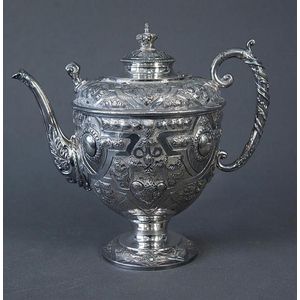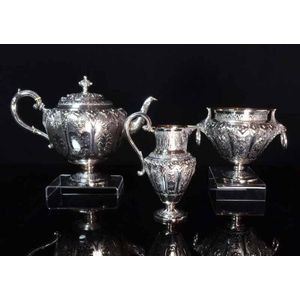Victorian Scottish Silver Tea Set with Engraved Floral Design
You must be a subscriber, and be logged in to view price and dealer details.
Subscribe Now to view actual auction price for this item
When you subscribe, you have the option of setting the currency in which to display prices to $Au, $US, $NZ or Stg.
- Cartouche - An ornamental panel in the form of of a shield, oval or rectangular scroll with curling edges. It may be carved into the back of a chair or the top of a sideboard, or present on a piece of silver or jewellery, and contain the initials of the original owner, heraldic symbols, or some other inscription, such as the details of a presentation.
In ceramics the term defines the central area of a vase or similar with a decorative border in one of the shapes above, into which a decorative scene or figures have been painted. - Victorian Period - The Victorian period of furniture and decorative arts design covers the reign of Queen Victoria from 1837 to 1901. There was not one dominant style of furniture in the Victorian period. Designers used and modified many historical styles such as Gothic, Tudor, Elizabethan, English Rococo, Neoclassical and others, although use of some styles, such as English Rococo and Gothic tended to dominate the furniture manufacture of the period.
The Victorian period was preceded by the Regency and William IV periods, and followed by the Edwardian period, named for Edward VII (1841 ? 1910) who was King of the United Kingdom and the British Dominions and Emperor of India for the brief period from 1901 until his death in 1910. - Engraving - The method of decorating or creating inscriptions on silver and other metal objects by marking the surface with a sharp instrument such as a diamond point or rotating cutting wheel.
- Embossed / Repousse - Embossing, also known as repousse, is the technique of decorating metal with raised designs, by pressing or beating out the design from the reverse side of the object.It is the opposite of chasing, where the decoration is applied from the front. An embossed or repoussed object may have chasing applied to finish off the design.
This item has been included into following indexes:
Visually similar items

A Victorian sterling silver 4pcs tea and coffee set maker 'C.E.N.', Sheffield 1897, comprising teapot, coffee pot, sugar bowl and cream jug decorated in the rococo style. Height 26 cm (coffee pot). Total approx weight 2467grams

Early silverplated coffee pot. Ornate embossed decoration. Stamped Walker & Hall to base. Height 27 cm

A Victorian sterling silver and cut crystal claret jug by Walter & George Sissons, Sheffield 1871. The jug is in the neoclassical style, with wheel-cut engraving to the glass bowl depicting leafy plant designs. Height 26 cm

A Victorian silver trophy cup, floral embellished design, vacant cartouche; George Unite, Birmingham, 1874.
